|
3.8. Group IV without feedback and with rule (fR n=15):
3.8.1. First fifty and last fifty trials:
All responses from individual trials were visually inspected and all uncontaminated by marked muscle or eye-movements artefacts were averaged.
Figures (3.8.1.a &b) show that the morphology was similar during the first fifty and the last fifty. As reported before the learners group elicited more positive going traces than the non-learners subjects did. 500msec pre-stimulus was similar in both groups, and up to 200msec post-stimulus.
Positive peaks were elicited by both conditions, the first fifty answer trials and the last fifty answer trials and the latencies were similar for each group separately. The last fifty answer trial stimuli elicited more positive going component than the first fifty answer trials.
The ERPs produced by the last fifty answer trials for the learners were distinguished from the non-learners by two more prominent positive peaks around 400msec and 680msec. The first fifty for the learners and non-learners were similar.
Cartoon brainmaps figures (3.8.2a & b) show that the both groups were similar pre-stimulus and at the beginning till about 150msec. About 200msec the learners and non-learners showed different brainmaps. In the group who trying to learn the task the positivity at the beginning at the occipital and parietal sites and then moved forward with time to the frontal sites. In the learning group brain positive activity at the beginning was frontal and distributed afterward to the occipital. It looks like the group of non-learners goes the opposite way of the brain active areas while performing the task. The learners brain activity for the last fifty differs from the first fifty appeared over the frontal, the anterior temporal, and the central area bilaterally from about 250msec and up to 700msec post-stimulus then localized over the frontal and the anterior temporal especially to the right-hand side. The non-learners brain activity was over the parietal and the posterior temporal bilaterally from 150msec and up to 350msec, then changed to be frontally especially to the right-hand side up to 700msec. Gradually the brain activity decreased from about 900msec for the learners and from 700msec for the non-learners up to the end of the task where there were no remarkable significant activity
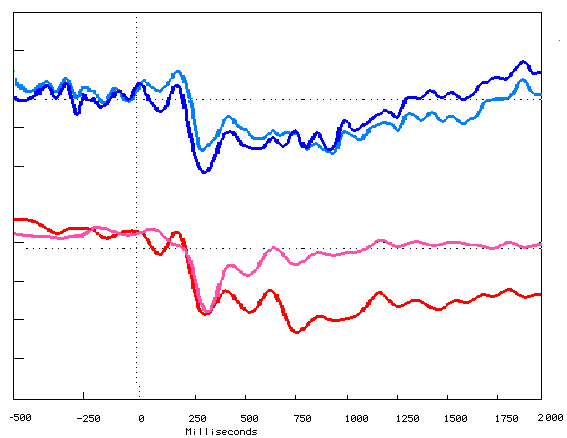
Figure 3.8.1a. Grand average ERPs elicited by the non-learners last fifty trials in blue color and the first fifty in light blue color represented by the top traces and the learners' last fifty trial traces in red color, the first fifty trials in light red color presented by the bottom traces. Recorded at FZ, Y-axis shows amplitude in Microvolts (
m n ), and X-axis shows latency in milliseconds (ms). The black vertical dotted line marks the point of stimulus onset, and the horizontal black dotted line represents the baseline. Upward deflection represents the negativity.
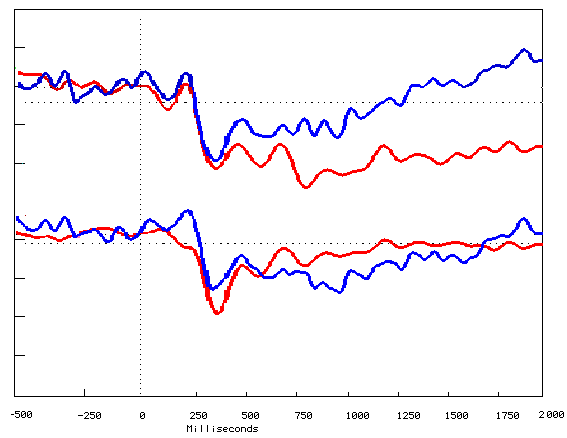
Figure 3.8.1b. Grand average ERPs elicited by the non-learners trial in blue color and the learners' trial traces in red color. The top traces represent the last fifty; the bottom traces represent the first fifty. Recorded at FZ, Y-axis shows amplitude in Microvolts (
m n ), and X-axis shows latency in milliseconds (ms). The black vertical dotted line marks the point of stimulus onset, and the horizontal black dotted line represents the baseline. Upward deflection represents the negativity.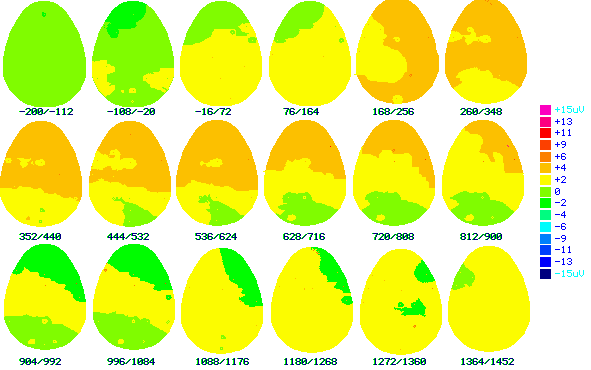
Figure (3.8.2a) shows the top view cartoon brainmaps made from the grand average ERPs elicited by the last fifty trials of the learners minus the first fifty. The numbers below each brainmap indicates the time in milliseconds when the map was computed. These results indicate 200msec before stimulus to 1452 msec post-stimulus. Color scale displays brain potentials from +15
m n in pink color, and –15 m n in dark blue. Frontal to the top, occipital to the bottom of the brain maps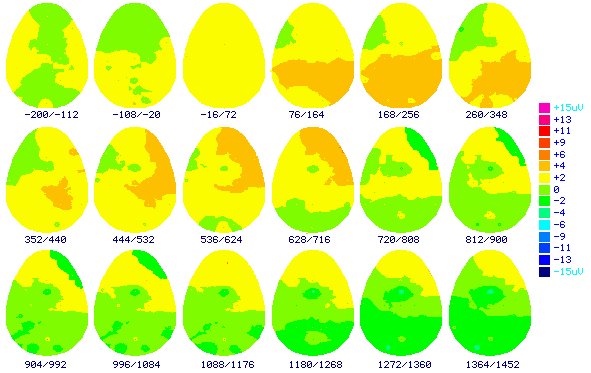
Figure (3.8.2b) shows the top view cartoon brainmaps made from the grand average ERPs elicited by the last fifty trials of the non-learners minus the first fifty. The numbers below each brainmap indicates the time in milliseconds when the map was computed. These results indicate 200msec before stimulus to 1452msec post-stimulus. Color scale displays brain potentials from +15
m n in pink color, and –15 m n in dark blue. Frontal to the top, occipital to the bottom of the brain maps
3.8.2. Correct and incorrect answers trials:
The group of learners brain activity stayed similar up to 200msec, then the correct answer trace showed positive peaks deflections stayed for about 1000msec. The group of non-learners stayed similar up to 450msec, then the positive deviation just stayed for 100msec, then the two traces were similar again up to the end of the task. A comparison between the learners and the non-learners showed that the pre-stimulus was the same in both of them up to 200msec and beyond 1200msec. The ERPs showed two positive peaks with latency of 300msec and 600msec in both groups. The positive amplitude was bigger for the learners group when compared with the non-learners, and the latencies were almost the same in the two conditions. In the learners group the positivity was more for the correct answers trials but the positive peaks latency was not similar where were delayed in case of the correct answers trials. The brain potentials elicit more positive activity on the right hemisphere at frontal sites and propagated to the central and parietal sites on both hemispheres.
The brainmaps are useful in showing more widespread effects, as we mentioned before that the individual electrodes gave us limited information as they reflect localized brain activity.
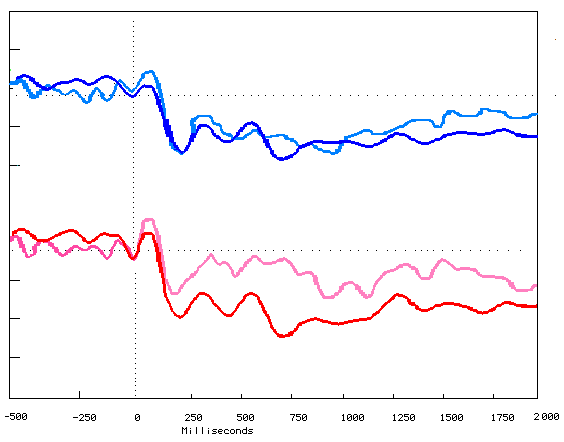
Figure 3.8.3a. Shows the grand averaged ERPs elicited by the non-learners correct answer trials in blue color and the incorrect answer trials in light blue color represented by the top traces and the learners correct answer trials traces in red color, the incorrect answer trials in light red color presented by the bottom traces. Recorded at FZ, Y-axis shows amplitude in Microvolts (
m n ), and X-axis shows latency in milliseconds (ms). The black vertical dotted line marks the point of stimulus onset, and the horizontal black dotted line represents the baseline. Upward deflection represents the negativity.
Figure (3.8.4a) shows the learners' top view cartoon brainmaps of made from the correct answer trials (LfR). There were significant brain activity recorded pre-stimulus and up to 50msec post-stimulus. The positive activity was distributed over the occipital, the parietal, the temporal areas and then distributed forward to the frontal and anterior temporal areas bilaterally, and more deviated to the right-hand side. The positive activity decreased gradually after 1100msec and beyond.
Figure (3.8.4b) shows the non-learners top view cartoon brainmaps of made from the correct answer trials (nLfR). There were no differences recorded pre-stimulus and up to 200msec post-stimulus. The positive activity started to appear parietally, and over the temporal areas bilaterally. Then the brain activity distributed over the frontal area and the temporal area especially to the right-hand side. The brain activity showed less positive amplitudes and different latencies when compared with the learners brain maps.
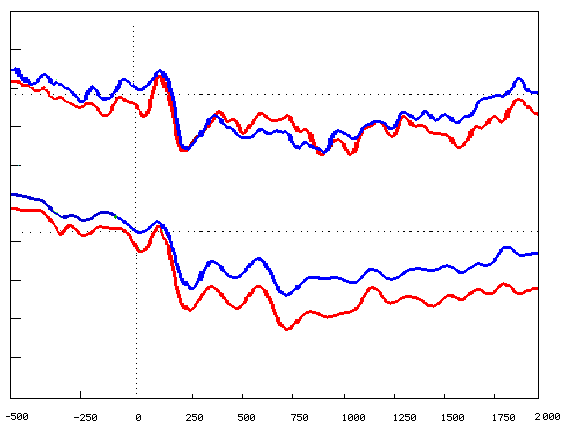
Figure (3.8.3b) shows the grand averaged ERPs elicited by the non-learners trial traces in blue color and the learners' trial traces in red color and the top traces represent the incorrect answer trials; the bottom traces represent the incorrect answer trials. Recorded at FZ, Y-axis shows amplitude in Microvolts (
m n ), and X-axis shows latency in milliseconds (ms). The black vertical dotted line marks the point of stimulus onset, and the horizontal black dotted line represents the baseline. Upward deflection represents the negativity.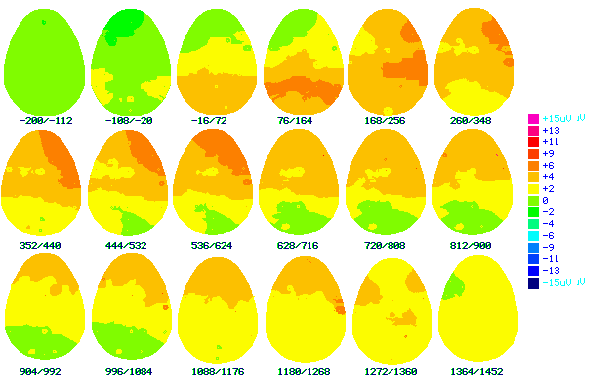
Figure (3.8.4a) shows the top view cartoon brainmaps made from grand average ERP elicited by the learners' correct answer trials. The numbers below each brainmap indicates the time in milliseconds when the map was computed. These results indicate 200msec before stimulus to 1452msec after stimulus. Color scale displays brain potentials from +15
m n in pink color, and –15 m n in dark blue. Frontal to the top, occipital to the bottom of the brain maps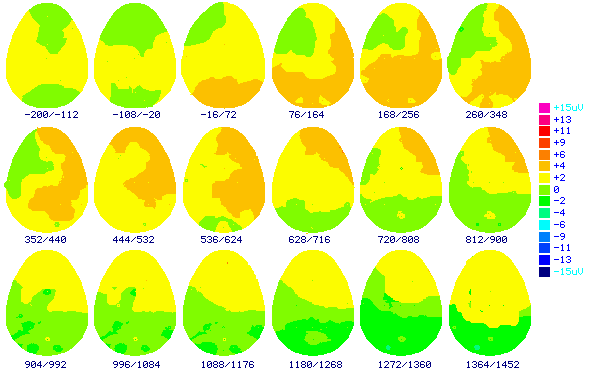
Figure (3.8.4b) shows the top view cartoon brainmaps made from grand average ERP elicited by the non-learners correct answers trials. The numbers below each brainmap indicates the time in milliseconds when the map was computed. These results indicate 200msec before stimulus to 1452 msec after stimulus. Color scale displays brain potentials from +15
m n in pink color, and –15 m n in dark blue. Frontal to the top, occipital to the bottom of the brain maps3.8.3. The regional differences:
The electrical activity was very similar in all parts of the brain pre-stimulus.
Furthermore, these figures clearly show a very marked front-occipital difference. The activity was more positive going over the frontal, the parietal, and the temporal areas especially on the right-hand side electrodes.
The comparison between the individual right-hand side versus the left-hand side electrodes for the learners during the last fifty answer trials. The frontal, central, and parietal lateral electrodes (Figure 3.8.5a). The lateral frontal and the anterior temporal electrodes (Figure 3.8.5b). The temporal and the temporal-parietal (Figure 3.8.5c)
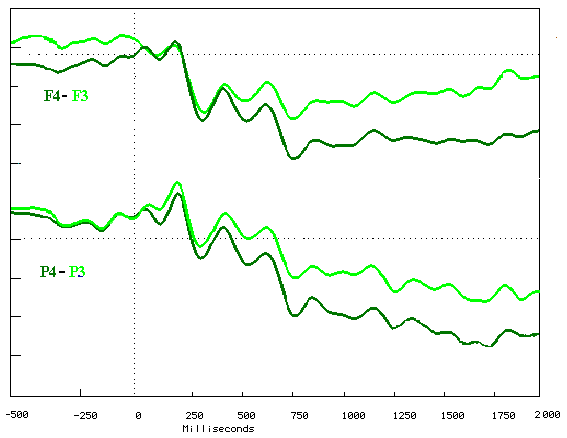
Figure (3.8.5a) shows the grand average ERPs elicited by all subjects' performance in group four. The right–hand side electrodes traces in dark green color, and the left-hand side electrodes traces in light green color. Recorded from the lateral frontal at F4-F3, and, the parietal area at P4-P3. Y-axis shows amplitude in Microvolts (
m n ), and X-axis shows latency in milliseconds (msec). The black vertical dotted line marks the point of stimulus onset, and the horizontal black dotted line represents the baseline. Upward deflection represents the negativity.
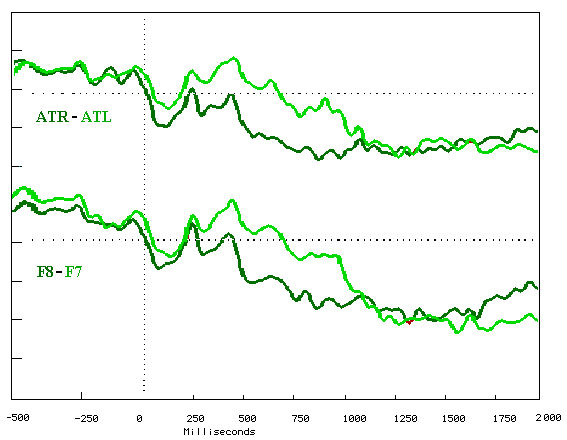
Figure (3.8.5b) shows the grand average ERPs elicited by all subjects' performance in group four. The right–hand side electrodes traces in dark green color, and the left-hand side electrodes traces in light green color. Recorded from the lateral frontal at F8-F7 and the anterior temporal area at ATR-ATL. Y-axis shows amplitude in Microvolts (
m n ), and X-axis shows latency in milliseconds (ms). The black vertical dotted line marks the point of stimulus onset, and the horizontal black dotted line represents the baseline. Upward deflection represents the negativity.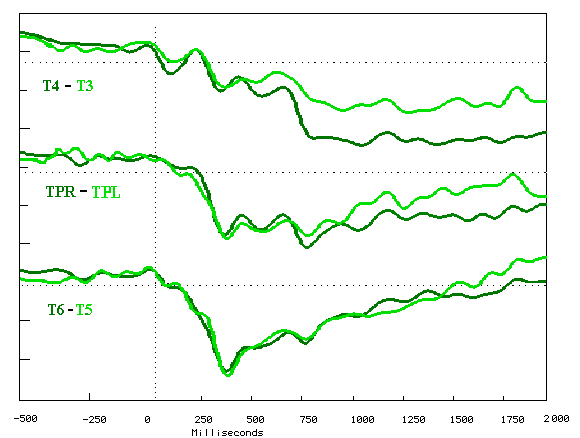
Figure (3.8.5c) shows the grand average ERPs elicited by all subjects' performance in group four. The right–hand side electrodes traces in green color, the left-hand side electrodes traces in blue color. Recorded from the tempro-parietal at TPR-TPL, the temporal at T4-T3 and the posterior temporal at T6-T5. Y-axis shows amplitude in Microvolts (
m n ), and X-axis shows latency in milliseconds (ms). The black vertical dotted line marks the point of stimulus onset, and the horizontal black dotted line represents the baseline. Upward deflection represents the negativity.Figures (3.8.6a &b) show the comparison between cartoon brainmap the right-hand side view versus the left-hand side view for the last fifty answer trials during the two time windows 250msec-550msec and 550msec-850msec. The positive activity was localized frontally and distributed backward to the anterior temporal and was more for the right-hand side view brainmaps during both time windows when compared to the left-hand side view. The activity distributed over the parietal, the central, the posterior temporal and the occipital areas which means that these areas were involved in the trials performance by the same value during this experiment condition trials and during the both windows. The positive activities were more for the large map right-hand side view during the first time window and the second time window.
The brain potentials elicit more positive activity on the right hemisphere at frontal sites and propagated to the temporal, the central and parietal sites on both hemispheres.
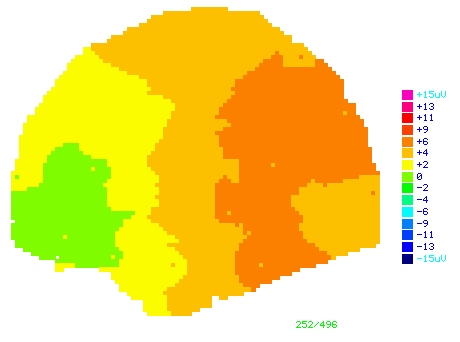
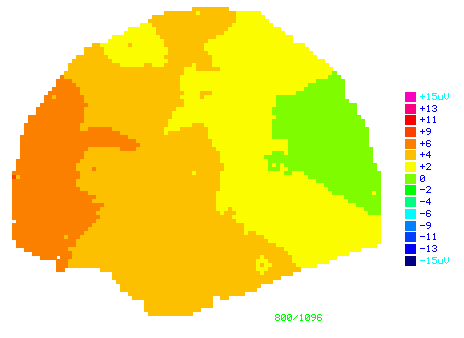
Figure (3.8.6a) shows the left-hand side view spatial maps made from the grand average ERPs elicited by the learners group last fifty stimuli. The numbers below each large map indicates the time in milliseconds when the map was computed. The first time interval 250msec to 550msec and the second time interval 550msec to 850msec after stimulus. Color scale displays brain potentials from +15
m n in pink color, and –15 m n in dark blue. The frontal area to the left-hand side and occipital area to the right-hand side of the brainmap
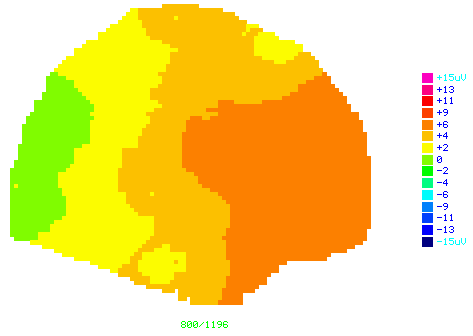
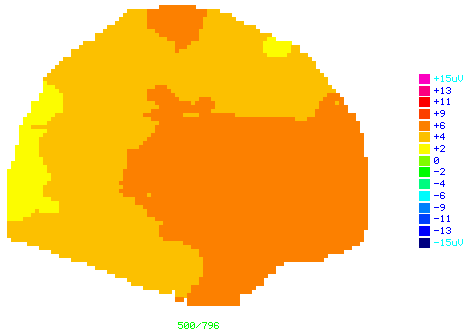
Figure (3.8.6b) shows the right-hand side view spatial maps made from the grand average ERPs elicited by the learners group last fifty trials. The numbers below each large map indicates the time in milliseconds when the map was computed. The first time interval 250msec to 550msec and the second time interval 550msec to 850msec after stimulus. Color scale displays brain potentials from +15 m n in pink color, and –15 m n in dark blue. The frontal area to the right-hand side and occipital area to the left-hand side of the brainmap
Table (3.8.1.) shows the comparison between the right-hand side with the left-hand side electrodes for the learners during the last fifty trials. There were statistically significant differences for the frontal area electrodes F4-F3 and the parietal area electrodes P4-P3 during the second time window. There was statistically significant difference for the frontal area electrodes F8-F7 and the anterior temporal electrode ATR-ATL during both time windows
|
Group |
Learners (LFR n=15) |
|
|
Electrodes sites |
1st window t value |
2nd window t value |
|
C4 - C3 |
1.03 |
1.08 |
|
F4 - F3 |
1.77 |
2.31** |
|
F8 - F7 |
2.87 ** |
3.66** |
|
O2 - O1 |
1.43 |
1.52 |
|
P4 - P3 |
1.79 |
2.77 ** |
|
TPR - TPL |
1.68 |
1.51 |
|
T4 - T3 |
1.09 |
0.96 |
|
T6 - T5 |
0.99 |
1.78 |
|
AT - ATL |
2.22 ** |
2.75 ** |
Table 3.6.1. Paired T-test results of the right-hand side versus the left-hand side electrodes for the last fifty trials (4th quartile) during both time windows